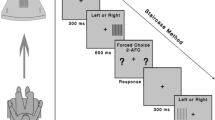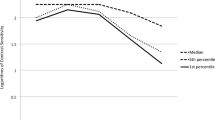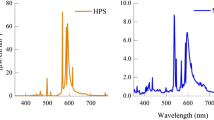Abstract
Background
The purpose of this study was to develop age-related curves for contrast sensitivity (CS) in normal subjects under day and night conditions with and without glare.
Methods
Sixty-one healthy eyes from 61 subjects were measured with the OPTEC® 6500 P under day and night conditions (luminance levels: 85 cd/m2 and 3.0 cd/m2 with and without glare; spatial frequencies: 1.5, 3, 6, 12 and 18 cycles/degree). A reliability analysis with five repeated measurements of six persons on 4 days was performed to examine the repeatability. The influence of age on contrast sensitivity, forward and backward scatter was examined by means of linear regression.
Results
Contrast sensitivity was significantly reduced under night conditions with glare, whereas glare had less influence under daylight illumination. Mean reliability coefficients are 0.87 (day), 0.77 (day with glare), 0.69 (night) and 0.81 (night with glare), which suggests sufficient retest reliability of the device. Regression analyses showed a highly significant influence of age, but the variance of the measurement values is not explained by age alone. The coefficients of determination for the regression of area under the log contrast sensitivity function (AULCSF) on age are 0.33 (photopic), 0.34 (photopic with glare), 0.29 (mesopic) and 0.36 (mesopic with glare, p < 0.0001 in all cases).
Conclusion
A significant relationship between age, CS and scatter was confirmed in our study. The results provide baseline values for the examination of patients with different diseases in which contrast sensitivity is impaired (such as glaucoma, cataracts and amblyopia) and might be useful in studies of roadworthiness or in investigation of the impact of intraocular lenses.





Similar content being viewed by others
References
Anderson SJ, Holliday IE (1995) Night driving: effects of glare from vehicle headlights on motion perception. Ophthalmic Physiol Opt 15:545–551
Artal P, Ferro M, Miranda I, Navarro R (1993) Effects of aging in retinal image quality. J Opt Soc Am A 10:1656–1662
Babizhayev MA (2003) Glare Disability and Driving Safety. Ophthalmic Res 35:19–25
Bach M (1996) The Freiburg Visual Acuity test-automatic measurement of visual acuity. Optom Vis Sci 73:49–53
Bellmann C, Unnebrink K, Rubin GS, Miller D, Holz FG (2003) Visual acuity and contrast sensitivity in patients with neovascular age-related macular degeneration. Results from the Radiation Therapy for Age-Related Macular Degeneration (RAD-) Study. Graefes Arch Clin Exp Ophthalmol 241:968–974
Bühren J, Terzi E, Bach M, Wesemann W, Kohnen T (2006) Measuring contrast sensitivity under different lighting conditions: comparison of three tests. Optom Vis Sci 83(5):290–298
Decina L, Staplin L (1993) Retrospective evaluation of alternative vision screening criteria for older and younger drivers. Accid Anal Prev. 25:267–275
De Natale R, Flammer J, Zulauf M, Bebie T (1988) Influence of Age on the Transparency of the Lens in Normals: a Population Study with Help of the Lens Opacity Meter 701. Ophthalmolgica 197:14–18
De Waard PW, IJspeert JK, van den Berg TJ, de Jong PT (1992) Intraocular light scattering in age-related cataracts. Invest Ophthalmol Vis Sci 33:618–625
Dougherty BE, Flom RE, Bullimore MA (2005) An evaluation of the Mars Letter Contrast Sensitivity Test. Optom Vis Sci 82:970–975
Elliott DB (1987) Contrast sensitivity decline with ageing: a neural or optical phenomenon? Ophthalmic Physiol Opt 7:415–419
Elliott DB, Bullimore MA (1993) Assessing the reliability, discriminative ability, and validity of disability glare tests. Invest Ophthalmol Vis Sci 34:108–119
Flammer J, Bebie H (1987) Lens Opacity Meter: a new instrument to quantify lens opacity. Ophthalmolgica 195:69–72
Giersch A, Speeg-Schatz C, Tondre M. Gottenkiene S (2006) Impairment of contrast sensitivity in long-term lorazepam users. Psychopharmacology (Berl) 186:594–600
Ginsburg AP (1981) Spatial Filtering and Vision: implications for Normal and abnormal Vision. Clinical Applications of Visual Psychophysics: 70
Ginsburg AP (1987) Contrast sensitivity, drivers’ visibility, and vision standards. From: Visibility for Highway Guidance and Hazard Detection, Transportation Research Record 1149, Transportation Research Board, National Research Council, Washington, DC 32–39
Ginsburg AP (1987) The Evaluation of Contact Lenses and Refractive Surgery Using Contrast Sensitivity. Contact Lenses: the CLAO Guide to Basic Science and Clinical Science Update 2
Ginsburg AP, Cheetham J, DeGryse R et al (1995) Effects of flurbiprofen and indomethacin on acute cystoid macular edema after cataract surgery: functional vision and contrast sensitivity. J Cataract Refract Surg 21:82–92
Ginsburg AP (1996) Next generation contrast sensitivity testing. In Rosenthal B, Cole R (eds) Functional Assessment of Low Vision. St. Louis Mosby Year Book, Inc. 77–88
Ginsburg AP (2006) Contrast sensitivity: determining the visual quality and function of cataract, intraocular lenses and refractive surgery. Curr Opin Ophthalmol 17:19–26
Guirao A, Gonzalez C, Redondo M, Geraghty E, Norrby S, Artal P (1999) Average optical performance of the human eye as a function of age in a normal population. Invest Ophthalmol Vis Sci. 40:203–213
Haymes SA, Roberts KF, Cruess AF, Nicolela Mt, LeBlanc RP, Ramsey MS, Chauhan BC, Artes PH (2006) The letter contrast sensitivity test: clinical evaluation of a new design. Invest Ophthalmol Vis Sci 47:2739–2745
Hitchcock EM, Dick RB, Krieg EF (2004) Visual contrast sensitivity testing: a comparison of two F.A.C.T. test types. Neurotoxicol and Teratol 26:271–277
Horn F, Martus P, Korth M (1995) Comparison of temporal and statiotemporal contrast-sensitivity tests in normal subjects and glaucoma patients. German J Ophthalmol 4:97–102
Horn FK, Junemann AG, Korth M (2001) Two methods of lens opacity measurements in glaucomas. Doc Ophthalmol 103:105–117
Ijspeert JK, de waard PWT, van den Berg TJTP, de Jong PTVM (1990) The intraocular straylight function in 129 healthy volunteers: dependence on angle, age and pigmentation. Vision Res 30:699–707
Jackson GR, Owsley C, McGwin G (1999) Aging and dark adaptation. Vision Research 39:3975–3982
Larsson E, Rydberg A, Holmström G (2006) Contrast sensitivity in 10 year old preterm and full term children: a population based study. British Journal of Ophthalmology 90:87–90
Kennedy RS, Dunlap WP (1990) Assessment of the Vistech contrast sensitivity test for repeated-measures applications. Optom Vis Sci 67:248–251
Kluka DA, Love PA (1993) The effects of daily-wear contact lenses upon contrast sensitivity in selected professional and collegiate female tennis players. J Am Optom Assoc 64:182–186
Lachenmayr B, Buser A, Keller O, Berger J (1996) Sehstörungen als Unfallursache. In: Berichte der Bundesanstalt für Straßenwesen (BASt). Mensch und Sicherheit. Wirtschaftsverlag NW, Bremerhaven, Heft M65
Lachenmayr B, Berger J, Buser A, Keller O (1998) Reduziertes Sehvermögen führt zu erhöhtem Unfallrisiko im Straßenverkehr. Ophthalmolog 95:44–50
Lachenmayr B (2005) Zur Lage der Begutachtung nach der Änderungsverordnung zur FeV. Ophthalmologe 102:27–32
Mäntyjärvi M, Laitinen T (2001) Normal values for the Pelli-Robson contrast sensitivity test. J Cataract Refract Surg 27:261–266
Marcos S (2001) Aberrations and visual performance following standard laser vision correction. J Refract Surg 17:S596–S601
Marmor MF, Gawande A (1988) Effect of visual blur on contrast sensitivity. Clinical implications. Ophthalmology 95:139–143
McKee SP, Klein SA, Teller DY (1985) Statistical properties of forced-choice psychometric functions: implications of probit analysis. Percept Psychophys 37:286–298
McLellan JS, Marcos S, Burns SA (2001) Age-related changes in monochromatic wave aberrations of the human eye. Invest Ophthalmol Vis Sci 42:1390–1395
Meacock WR, Spalton DJ, Boyce J, Marshall J (2003) The effect of posterior capsule opacification on visual function. Invest Ophthalmol Vis Sci 44:4665–4669
Nadler MP, Miller D, Nadler DJ (1990) Glare and Contrast Sensitivity For Clinicans. Springer, New York
Nomura H, Ando F, Niino N, Shimokata H, Miyake Y (2003) Age-related Change in Contrast Sensitivity Among Japanese Adults. Jpn J Ophthalmol 47:299–303
Pesudovs K, Hazel CA, Doran RML, Elliott DB (2004) The usefulness of Vistech and FACT contrast sensitivity charts for cataract and refractive surgery outcomes resarch. Br J Ophthalmol 88:11–16
Scharwey K, Krzizok T, Herfurth M (1998) Night driving capacity of ophthalmologically healthy persons of various ages. Ophthalmologe 95:555–558
Sloane ME, Owsley C, Alvarez SL (1988) Aging, senile miosis and spatial contrast sensitivity at low luminance. Vision Research 28:1235–46P
Terzi E, Bühren J, Wesemann W, Kohnen T (2005) [Frankfurt-Freiburg Contrast and Acuity Test System (FF-CATS). A new test to determine contrast sensitivity under variable ambient and glare luminance levels]. Ophthalmolge 102:507–513
Thayaparan K, Crossland MD, Rubin GS (2006) Clinical assessment of two novel contrast sensitivity charts. Br J Ophthalmol. DOI 17166891
van den Berg TJTP (1986) Importance of pathological intraocular scatter for visual disability. Doc Ophthalmol 61:327–333
van Rijn LJ, Nischler C, Gamer D, Franssen L, de Wit G, Kaper R, Vonhoff D, Grabner G, Wilhelm H, Volker-Dieben HJ, van den Berg TJ (2005) Measurement of stray light and glare: comparison of Nyktotest, Mesotest, stray light meter, and computer implemented stray light meter. Br J Ophthalmol 89:345–351
Wesner MF, Tan J (2006) Contrast sensitivity in seasonal and nonseasonal depression. J Affect Disord 95:19–28
Williams DR (2002) What adaptive optics can do for the eye. Rev Refract Surg 3:14–20
Yamane N, Miyata K, Samejima T et al (2004) Ocular higher-order aberrations and contrast sensitivity after conventional laser in situ keratomileusis. Invest Ophthalmol Vis Sci 45:3986–3990
Yoon G, Jeong TE, Cox IG, Williams DR (2004) Vision improvement by correcting higher-order aberrations with phase plate in normal eyes. J Refract Surg 20:523–527
Author information
Authors and Affiliations
Corresponding author
Additional information
Supported by: Deutsche Forschungsgemeinschaft, Bonn, Germany (SFB 539).
Rights and permissions
About this article
Cite this article
Hohberger, B., Laemmer, R., Adler, W. et al. Measuring contrast sensitivity in normal subjects with OPTEC® 6500: influence of age and glare. Graefes Arch Clin Exp Ophthalmol 245, 1805–1814 (2007). https://doi.org/10.1007/s00417-007-0662-x
Received:
Revised:
Accepted:
Published:
Issue Date:
DOI: https://doi.org/10.1007/s00417-007-0662-x




